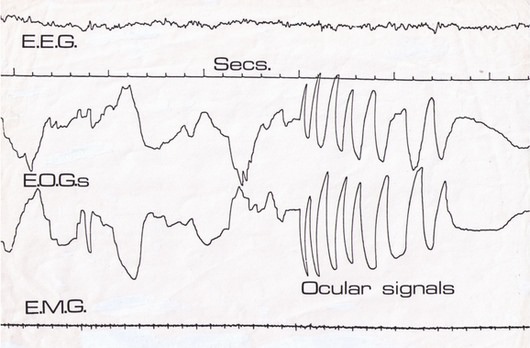

In a lucid dream, you know you're dreaming. It's this crucial realization that triggers your consciousness to surface in slumberland, enabling you to:
Experts agree that everyone has the potential for lucid dreaming. Yet only a fraction of people learn how to have lucid dreams frequently. This website is made by lucid dreamers for anyone who is serious about lucid dreaming and exploring its life-altering applications.
The first scientific research into lucid dreaming took place in 1975, when Dr Keith Hearne recorded a set of pre-determined eye movements from his volunteer, Alan Worsley.
Inside the sleep lab, Worsley became lucid in a dream and moved his eyes in an agreed pattern, while his real eyes tracked in exactly the same way. Using an electrooculogram (EOG), Hearne was able to scientifically record the communication between the dreamer and the waking world.

Researchers have since used brainwave and bloodflow data to validate higher levels of consciousness in lucid dreaming participants. For instance, this Frankfurt study of lucid dreamers captured brainwave frequencies in the 40 Hz (aka Gamma range) while dreaming.
This measure is far more active than the normal dream state, which takes place in the Theta range, or 4-7 Hz. Some researchers argue that lucid dreaming should be classified as a new state of consciousness.
What's more, the research also showed heightened activity in the frontal and frontolateral areas of the dreaming brain. This is the seat of linguistic thought and other higher mental functions linked to self awareness.
A fully lucid dream can be tangible, rich, and visually detailed. When probed or prompted, it can generate surprising new levels of perception, like 360-degree vision or multiple timelines playing out in the same space.
And because everything takes place in the dream world, there are no laws, boundaries, or limitations. Anything you can conceive of comes true.

But lucid dreaming isn't just about creating fantasy worlds. Psychoanalytical theory suggests it's a chance to interact with other parts of your self by talking to different dream characters. You can even speak to the very fabric of the dream.
There are numerous published accounts of how lucid dreaming has helped veterans with PTSD; athletes seeking to gain the edge over the competition; and children suffering from debilitating phobias.
Once you know how to become lucid in dreams, you will discover a universe in which you can become fully awake while dreaming. You can control the dream or let the dream control itself, all the while experiencing its characters, symbols, and messages with clarity.
First, you must recognize that you're dreaming in order to become lucid. This brings your consciousness into the dream with a BOOM. The more conscious you become of your dream environment, the easier it is to manipulate with:
The golden rule for lucid dream control is that if you expect or believe something will happen, then it does, just like Neo in The Matrix. This works just as well with dark or scary themes in lucid dreams, so don't watch horror movies before bed...

When lucid dreaming, you'll find you can exert considerable control over yourself, your fellow dream personalities, the scenery, and the events that unfold. But you don't have to control anything. In fact, to passively experience a lucid dream means to focus on your heightened awareness and watch the dream unfold in its "intended" state.
Beginners sometimes find their lucid dreams end prematurely, usually due to the sheer excitement and adrenaline rush brought about by a lucid dream. It's also possible to lose your self awareness and forget you're dreaming, so that you slip back into the regular dream state.
To make your lucid dreams last longer, cultivate a calm and focused mind set in the dream world. A simple way to enhance your lucidity, and thereby prolong your lucid dream, is to rub your hands together while saying "I'm dreaming".
This kinetic sensation stimulates the conscious brain, while drawing awareness to your dream body and away from your physical body that is laying asleep in bed. Such techniques have enabled me to experience lucid dreams as long as an hour in real time.
In your lucid dreams, you can seek out or summon any person, dead or alive, fictional or real.
A good way to do this is to heighten your lucidity, then visualize and expect the person you want to meet just out of sight. Ask the dream out loud to manifest that person.
Don't be afraid to ask for surreal personas: "Show me myself in 10 years", "Show me my ideal partner", and "Show me how my great-great-grandchildren will live" are all valid requests in the lucid dream state.
Making the lucid dream scene morph in front of your eyes can sometimes be difficult. With your expectation guiding what happens, you may find it too hard simply because that's not how you've experienced real life to work.
Fortunately, other lucid dreamers have been working the dream world long enough to have come up with some excellent solutions:
![]()
There are lots of creative solutions to issues of dream control. The most important thing to remember is that your expectations and beliefs strongly drive what happens next.
Stay confident in your ability to summon a Greek Goddess, burrow into the Earth's core, or experience the dream with only the perceptions of a blue whale. You'll find that absolutely anything is possible inside a lucid dream!
If you're committed to learning lucid dreaming, we encourage you to access our premium content at the World of Lucid Dreaming Academy.
You'll work through our 30-module lucid dreaming course, supported by hours of expert interviews, guided meditation audios, and our own private community of lucid dreamers.